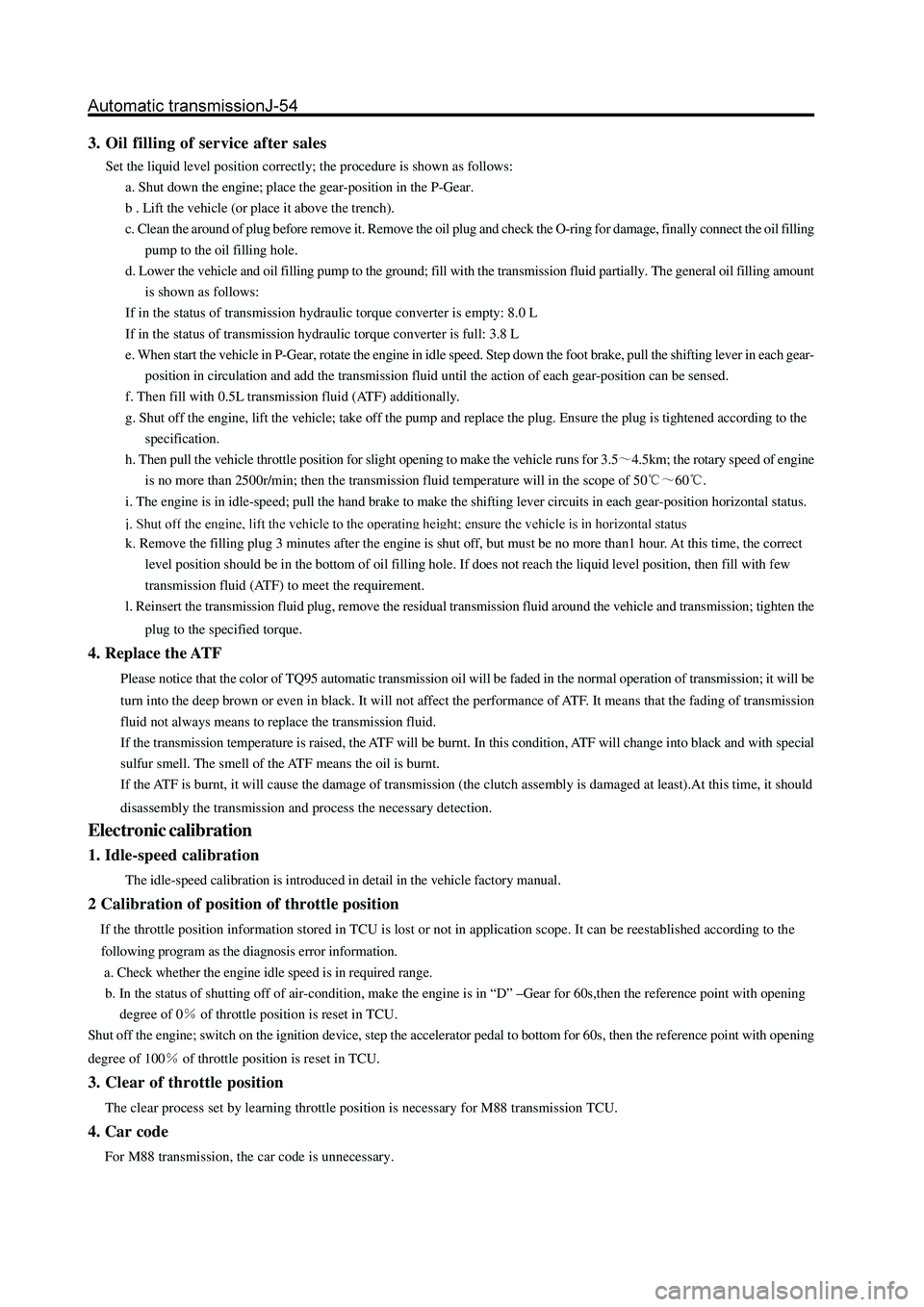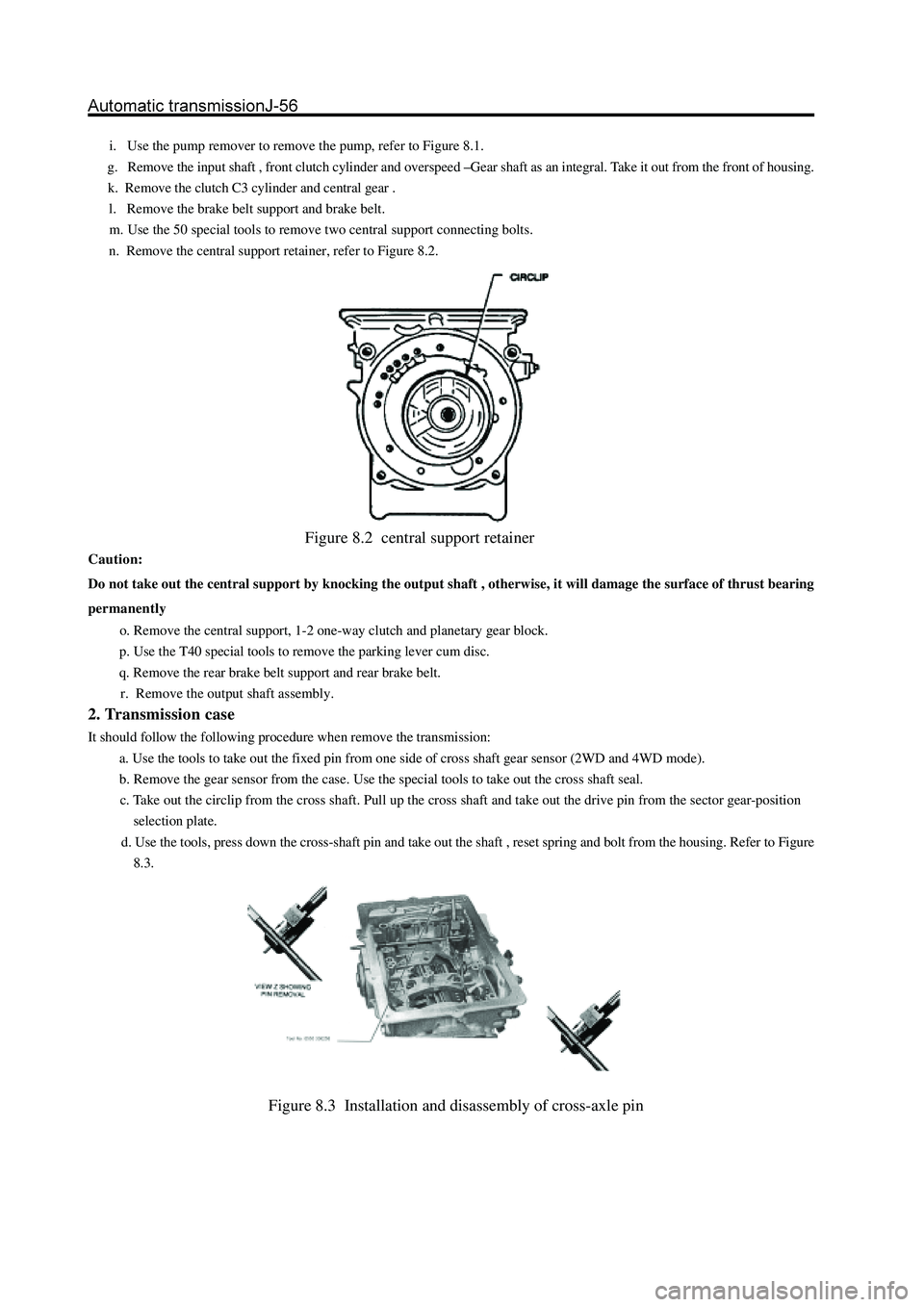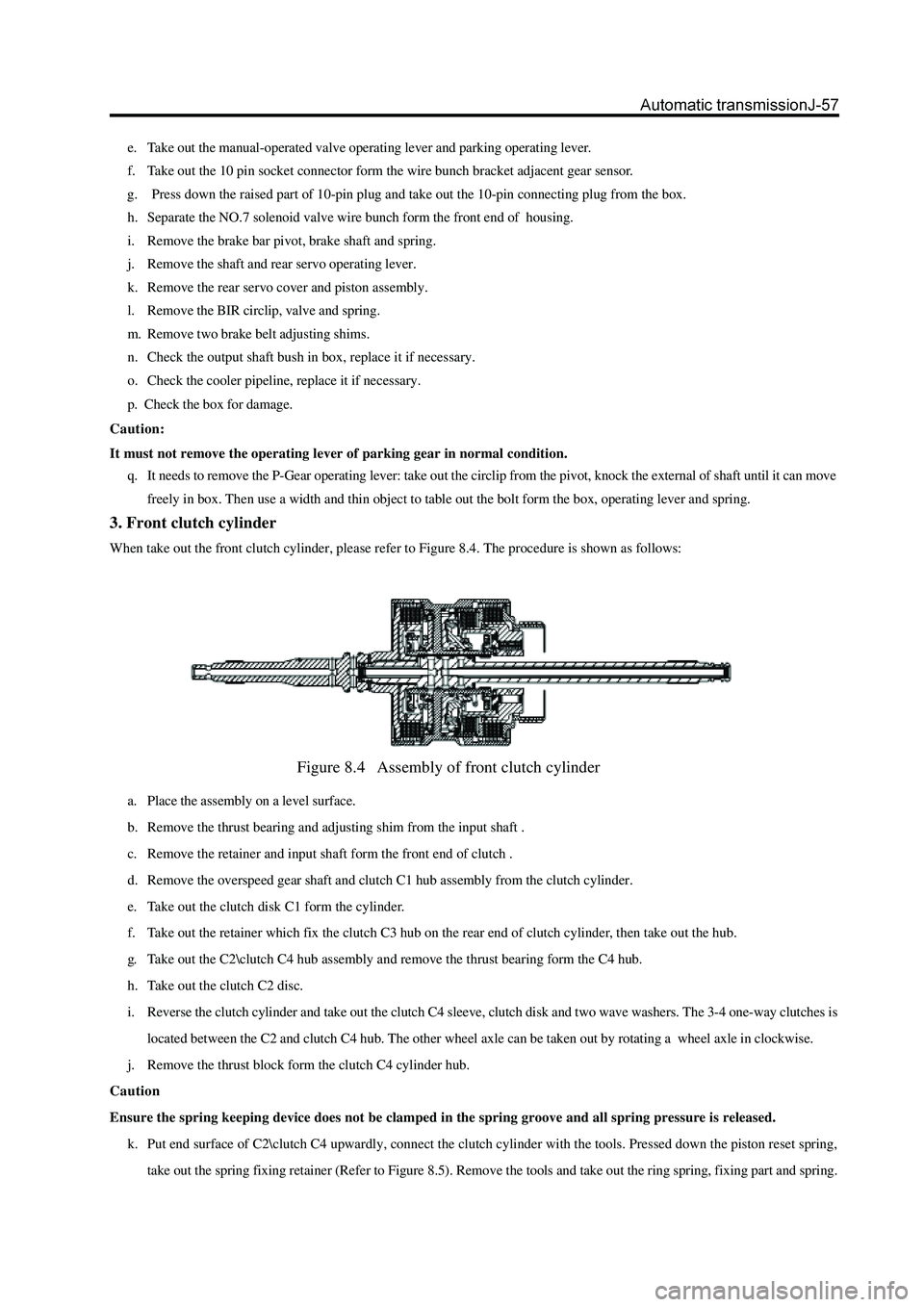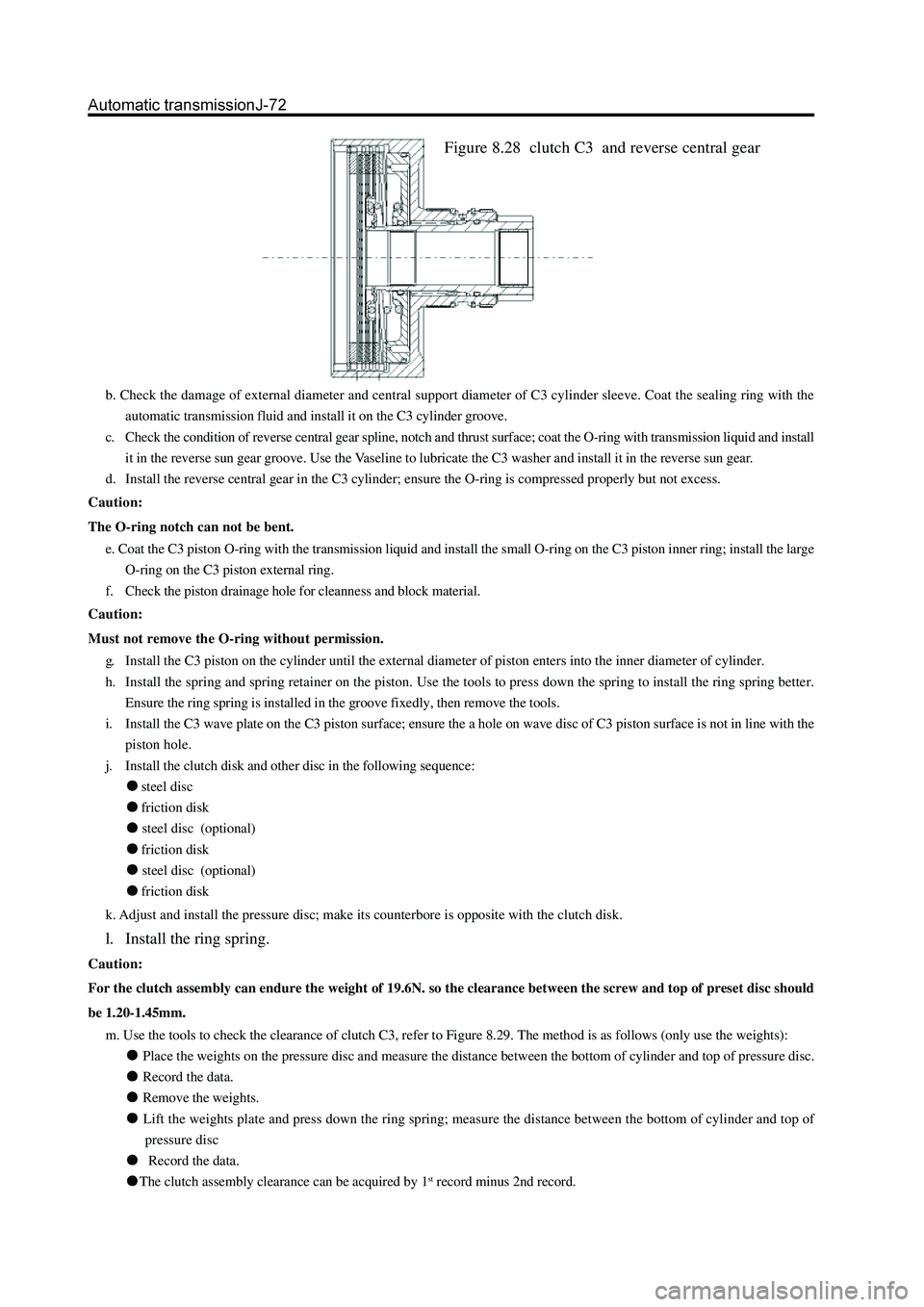2006 GREAT WALL HOVER reset
[x] Cancel search: resetPage 130 of 425

3. Oil filling of service after sales
Set the liquid level position correctly; the procedure is shown as follows:
a. Shut down the engine; place the gear-position in the P-Gear.
b . Lift the vehicle (or place it above the trench).
c. Clean the around of plug before remove it. Remove the oil plug and check the O-ring for damage, finally connect the oil filling
pump to the oil filling hole.
d. Lower the vehicle and oil filling pump to the ground; fill with the transmission fluid partially. The general oil filling amount
is shown as follows:
If in the status of transmission hydraulic torque converter is empty: 8.0 L
If in the status of transmission hydraulic torque converter is full: 3.8 L
e. When start the vehicle in P-Gear, rotate the engine in idle speed. Step down the foot brake, pull the shifting lever in each gear-
position in circulation and add the transmission fluid until the action of each gear-position can be sensed.
f. Then fill with 0.5L transmission fluid (ATF) additionally.
g. Shut off the engine, lift the vehicle; take off the pump and replace the plug. Ensure the plug is tightened according to the
specification.
h. Then pull the vehicle throttle position for slight opening to make the vehicle runs for 3.5
4.5km; the rotary speed of engine
is no more than 2500r/min; then the transmission fluid temperature will in the scope of 50
60.
i. The engine is in idle-speed; pull the hand brake to make the shifting lever circuits in each gear-position horizontal status.
k. Remove the filling plug 3 minutes after the engine is shut off, but must be no more than1 hour. At this time, the correct
level position should be in the bottom of oil filling hole. If does not reach the liquid level position, then fill with few
transmission fluid (ATF) to meet the requirement.
l. Reinsert the transmission fluid plug, remove the residual transmission fluid around the vehicle and transmission; tighten the
plug to the specified torque.
4. Replace the ATF
Please notice that the color of TQ95 automatic transmission oil will be faded in the normal operation of transmission; it will be
turn into the deep brown or even in black. It will not affect the performance of ATF. It means that the fading of transmission
fluid not always means to replace the transmission fluid.
If the transmission temperature is raised, the ATF will be burnt. In this condition, ATF will change into black and with special
sulfur smell. The smell of the ATF means the oil is burnt.
If the ATF is burnt, it will cause the damage of transmission (the clutch assembly is damaged at least).At this time, it should
disassembly the transmission and process the necessary detection.
Electronic calibration
1. Idle-speed calibration
The idle-speed calibration is introduced in detail in the vehicle factory manual.
2 Calibration of position of throttle position
If the throttle position information stored in TCU is lost or not in application scope. It can be reestablished according to the
following program as the diagnosis error information.
a. Check whether the engine idle speed is in required range.
b. In the status of shutting off of air-condition, make the engine is in “D” –Gear for 60s,then the reference point with opening
degree of 0
of throttle position is reset in TCU.
Shut off the engine; switch on the ignition device, step the accelerator pedal to bottom for 60s, then the reference point with opening
degree of 100
of throttle position is reset in TCU.
3. Clear of throttle position
The clear process set by learning throttle position is necessary for M88 transmission TCU.
4. Car code
For M88 transmission, the car code is unnecessary.
Page 132 of 425

Caution:
Do not take out the central support by knocking the output shaft , otherwise, it will damage the surface of thrust bearing
permanently
o. Remove the central support, 1-2 one-way clutch and planetary gear block.
p. Use the T40 special tools to remove the parking lever cum disc.
q. Remove the rear brake belt support and rear brake belt.
r. Remove the output shaft assembly.
2. Transmission case
It should follow the following procedure when remove the transmission:
a. Use the tools to take out the fixed pin from one side of cross shaft gear sensor (2WD and 4WD mode).
b. Remove the gear sensor from the case. Use the special tools to take out the cross shaft seal.
c. Take out the circlip from the cross shaft. Pull up the cross shaft and take out the drive pin from the sector gear-position
selection plate.
d. Use the tools, press down the cross-shaft pin and take out the shaft , reset spring and bolt from the housing. Refer to Figure
8.3.
Figure 8.3 Installation and disassembly of cross-axle pinFigure 8.2 central support retainer
i. Use the pump remover to remove the pump, refer to Figure 8.1.
g. Remove the input shaft , front clutch cylinder and overspeed –Gear shaft as an integral. Take it out from the front of housing.
k. Remove the clutch C3 cylinder and central gear .
l. Remove the brake belt support and brake belt.
m. Use the 50 special tools to remove two central support connecting bolts.
n. Remove the central support retainer, refer to Figure 8.2.
Page 133 of 425

e. Take out the manual-operated valve operating lever and parking operating lever.
f. Take out the 10 pin socket connector form the wire bunch bracket adjacent gear sensor.
g. Press down the raised part of 10-pin plug and take out the 10-pin connecting plug from the box.
h. Separate the NO.7 solenoid valve wire bunch form the front end of housing.
i. Remove the brake bar pivot, brake shaft and spring.
j. Remove the shaft and rear servo operating lever.
k. Remove the rear servo cover and piston assembly.
l. Remove the BIR circlip, valve and spring.
m. Remove two brake belt adjusting shims.
n. Check the output shaft bush in box, replace it if necessary.
o. Check the cooler pipeline, replace it if necessary.
p. Check the box for damage.
Caution:
It must not remove the operating lever of parking gear in normal condition.
q. It needs to remove the P-Gear operating lever: take out the circlip from the pivot, knock the external of shaft until it can move
freely in box. Then use a width and thin object to table out the bolt form the box, operating lever and spring.
3. Front clutch cylinder
When take out the front clutch cylinder, please refer to Figure 8.4. The procedure is shown as follows:
Figure 8.4 Assembly of front clutch cylinder
a. Place the assembly on a level surface.
b. Remove the thrust bearing and adjusting shim from the input shaft .
c. Remove the retainer and input shaft form the front end of clutch .
d. Remove the overspeed gear shaft and clutch C1 hub assembly from the clutch cylinder.
e. Take out the clutch disk C1 form the cylinder.
f. Take out the retainer which fix the clutch C3 hub on the rear end of clutch cylinder, then take out the hub.
g. Take out the C2\clutch C4 hub assembly and remove the thrust bearing form the C4 hub.
h. Take out the clutch C2 disc.
i. Reverse the clutch cylinder and take out the clutch C4 sleeve, clutch disk and two wave washers. The 3-4 one-way clutches is
located between the C2 and clutch C4 hub. The other wheel axle can be taken out by rotating a wheel axle in clockwise.
j. Remove the thrust block form the clutch C4 cylinder hub.
Caution
Ensure the spring keeping device does not be clamped in the spring groove and all spring pressure is released.
k. Put end surface of C2\clutch C4 upwardly, connect the clutch cylinder with the tools. Pressed down the piston reset spring,
take out the spring fixing retainer (Refer to Figure 8.5). Remove the tools and take out the ring spring, fixing part and spring.
Page 134 of 425

l. Reverse the clutch cylinder on the pressure machine; and remove the clutch C1 reset spring with same method.
m. Send the compressed air into the cylinder through the cylinder hole, remove the clutch piston from the clutch cylinder. Refer
to Figure 8.6.
4.clutch C3 cylinder
The procedure of removal of clutch C3 cylinder is shown as follows:
a. Remove the front sun gear assembly, thrust bearing and thrust washer from the clutch C3 cylinder asse bly , shown as Figure
8.7.
b. Remove the nylon thrust bearing, bearing block, needle thrust bearing and thrust bearing . From the clutch cylinder hub.
Figure 8.5 Impressed clutch reset spring
Figure 8.7 Clutch C3 and central gear assemblyFigure 8.6 Removal of C1, C2 and clutch C4 piston
Page 148 of 425

b. Check the damage of external diameter and central support diameter of C3 cylinder sleeve. Coat the sealing ring with the
automatic transmission fluid and install it on the C3 cylinder groove.
c. Check the condition of reverse central gear spline, notch and thrust surface; coat the O-ring with transmission liquid and install
it in the reverse sun gear groove. Use the Vaseline to lubricate the C3 washer and install it in the reverse sun gear.
d. Install the reverse central gear in the C3 cylinder; ensure the O-ring is compressed properly but not excess.
Caution:
The O-ring notch can not be bent.
e. Coat the C3 piston O-ring with the transmission liquid and install the small O-ring on the C3 piston inner ring; install the large
O-ring on the C3 piston external ring.
f. Check the piston drainage hole for cleanness and block material.
Caution:
Must not remove the O-ring without permission.
g. Install the C3 piston on the cylinder until the external diameter of piston enters into the inner diameter of cylinder.
h. Install the spring and spring retainer on the piston. Use the tools to press down the spring to install the ring spring better.
Ensure the ring spring is installed in the groove fixedly, then remove the tools.
i. Install the C3 wave plate on the C3 piston surface; ensure the a hole on wave disc of C3 piston surface is not in line with the
piston hole.
j. Install the clutch disk and other disc in the following sequence:
steel disc
friction disk
steel disc (optional)
friction disk
steel disc (optional)
friction disk
k. Adjust and install the pressure disc; make its counterbore is opposite with the clutch disk.
l. Install the ring spring.
Caution:
For the clutch assembly can endure the weight of 19.6N. so the clearance between the screw and top of preset disc should
be 1.20-1.45mm.
m. Use the tools to check the clearance of clutch C3, refer to Figure 8.29. The method is as follows (only use the weights):
Place the weights on the pressure disc and measure the distance between the bottom of cylinder and top of pressure disc.
Record the data.
Remove the weights.
Lift the weights plate and press down the ring spring; measure the distance between the bottom of cylinder and top of
pressure disc
Record the data.
The clutch assembly clearance can be acquired by 1st record minus 2nd record.
Figure 8.28 clutch C3 and reverse central gear
Page 377 of 425

Safety airbag-7
Description of flash code
The failure code transmission is completed by SRS-ECU’s input to the defined diagnostic scanner through the maintenance system’s
serial data interface. (X-431 diagnostic scanner) Failure code of diagnosis
Failure Failure code Flash code
1 No storage error $12
2 Front airbag driver’s, high resistance $9,021 $21
3 Front airbag driver’s , low resistance $9,022 $22
4 Front airbag driver ’s, short-circuit of GND $9,024 $24
5 front airbag driver ’s , short –circuit of VBATT $9,025 $25
6 front airbag passenger, high resistance $9,015 $15
7 front airbag passenger, low resistance $9,016 $16
8 front airbag passenger , short-circuit of GND $9,018 $18
9 Front airbag passenger , short-circuit of VBTT $9,019 $19
10 High voltage of battery $9,031 $31
11 Low voltage of battery $9,032 $32
12 Failure of alarm lamp $9,061 $61
13 Internal failure (replace SDM) $9,071 $71
14 Front collision record $9,051 $51
15 Side collision driver’s record $9,056 $56
16 Side collision passenger record $9,057 $57
17 Retightened safety belt collision $9,058 $58
18 Beyond the allowable repeat usage times $9,054 $54
3. Interior failure
The micro controller can test the following items not only in starting detection but also in cyclic diagnosis detection.
a. Ignition circuit triggers the transistor: The high-side transistor is detected not only in the starting detection but also in the
circulation diagnosis. But for the low-side transistor is opened when is connected to power supply directly, so the low-side
transistor only can be detected in the starting detection to avoid the misexplosion.
b. The ignition voltage is provided by the booster transformer.
c. The acceleration sensor is detected by itself when start the detection.
d. Allowable deviation scope of acceleration sensor in circulation diagnosis.
e. Micro controller includes (AD converter, ROM, RAM etc.)
f. Status of safety sensor
Cautions:
Connector of explosion tube circuit has the short-circuit bar. When the connector is not connected, the end (+) of
explosion tube is connected to end (-) directly to prevent the failure outspread caused by static. When the connector
is bas and short-circuit bar is connected, the failure may not be eliminated.
An external watch dog can detect the operating status of micro controller. It can trigger the watchdog when the micro con
troller has failure. The watch dog will reset the micro-controller and light the alarm lamp.
Page 378 of 425

Safety airbag-8
Internal failure determined by SRS-ECU
Serial
No. List of failure Description of failure
1 Micro-controller AD converter or EEPROM is faulty (the micro controller will be reset
and alarm lamp is light when the RAM has failure.)
2 Driver’s front airbag ignition loop Enable the failure
Measure the failure of loop
3 Passenger front airbag ignition loop
(if realized) Enable the failure
Measure the failure of loop
4 Seat safety belt preloaded ignition loop
(if realized) Enable the failure
Measure the failure of loop
5 Passenger side safety belt preloaded
ignition loop (if realized) Enable the failure
Measure the failure of loop
6 Driver’s side airbag ignition loop
(if realized) Enable the failure
Measure the failure of loop
7 Passenger side airbag ignition loop
(if realized ) Enable the failure
Measure the failure of loop
8 Maximum times of explosion of safet y
belt pre-tightener Reach the maximum value 6
9 Holding time of ECU ener gy
(self-supply time) Too short
10 Accelerometer Deviation range
Sensor not in constant, stable model
Sensor tests the failure itself
11 The measurement of ignition loop is
rejected continuously No cycling diagnosis test (duplicated calculation)
12 Safety sensor Calculate the safety sensor open-loop using the method that power-off
for 2 or more than 2 seconds is considered as passing
13 Initial firing current All initial firing current in normal status when the front airbag releases.
14 The ignition of side airbag is not
determined. Though SRS-ECU has received ignition information for 5 times during
HSIS cycling ignition, the ignition can not be determined due to the side
safety..
Debug the failure codes
Approach 1. The failure codes will be debugged following the ECU’s receipt from the X-431 diagnostic tester of the debugging
failure codes order through the serial interface, however, if an internal failure code is recorded or one impact is
recorded, the debugging will not be executed.
Approach 2. Ground 488# line for 5 times in 10 seconds to debug the failure codes.
Failure status display (alarm lamp keeps illuminating).
1. Bulb test
SRS-ECU will light the alarm lamp in order to test the bulb after working voltage is provided to it through the battery. The lamp
will flash for 6 times and then extinguish at 1HZ in the initial phase. The alarm lamp will keep illuminating after the working
voltage is provided in order to inform the driver’s system failures. The alarm lamp will keep illuminating for 6 seconds after the
ignition on and then be extinguished if the history-accumulated failures are less than five times. In the initial phase, SRS-ECU will
not prepare to test impact and stop release till the circuit is stable. Therefore, alarm lamp’s display manner will be one of
following projects in the initial phase. (Table 4.9).
Project 1. If the impact is recorded or the number of history accumulated failures is or more than 5,the alarm lamp will keep
illuminating, simultaneously, it will also keep illuminating if there is a possible explosion failure.